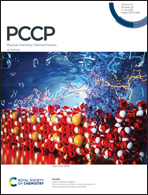Role of the carrier density in the transport mechanisms of polycrystalline ZnO films
Abstract
The transport processes occurring in polycrystalline ZnO have been investigated by measuring the resistivity as a function of temperature in ZnO films with different n-doping levels, obtained by varying the oxygen pressure during the deposition process. These films show an electrical resistivity spanning about two orders of magnitude, from 4 to 8 × 10−2 Ω cm at room temperature, corresponding to low and high levels of n-type doping, respectively. The present results indicate a relevant role of the carrier density in determining the dominant transport mechanisms in these samples by showing that the picture characterizing a highly n-doped ZnO sample, where an intra-grain mechanism and a grain-boundary mechanism dominate the high temperature and low temperature transport processes, respectively, is thoroughly overturned in lightly n-doped samples, where a grain-boundary mechanism and an intra-grain mechanism govern the charge transport in the same temperature regimes, respectively. Moreover, the present results indicate a critical role of the conditions limiting the occurrence of the Mott variable range hopping regime. They show indeed that an incomplete check of such conditions can result in erroneous conclusions about the prevalent transport mechanisms.



 Please wait while we load your content...
Please wait while we load your content...